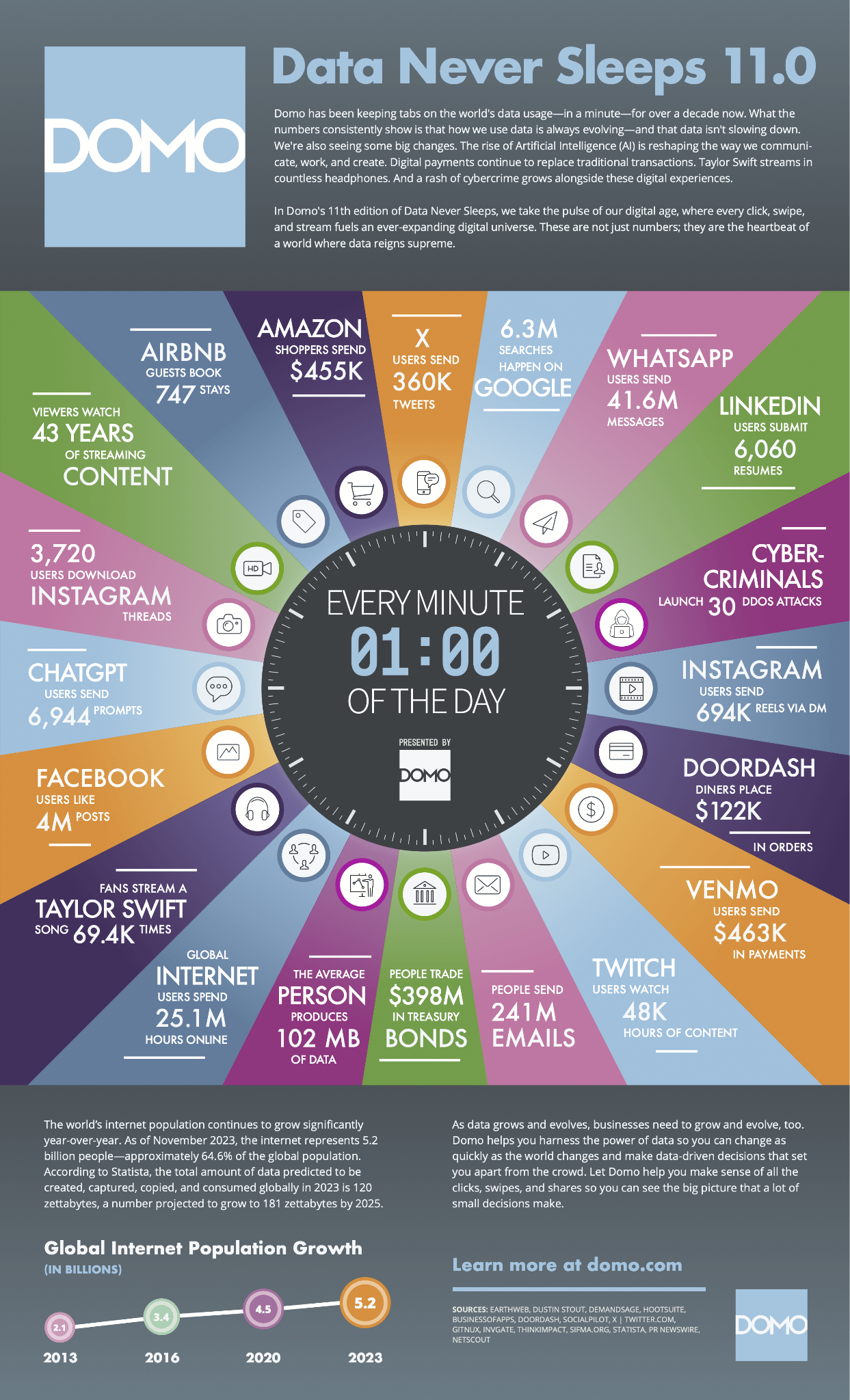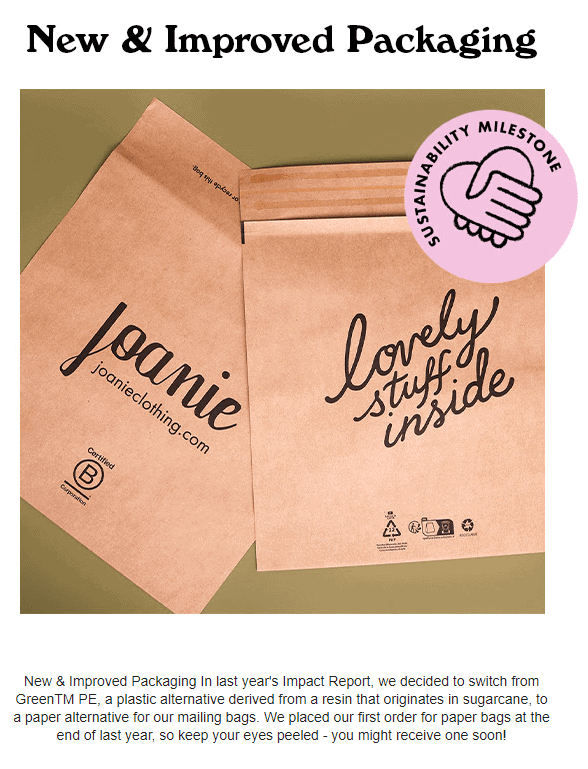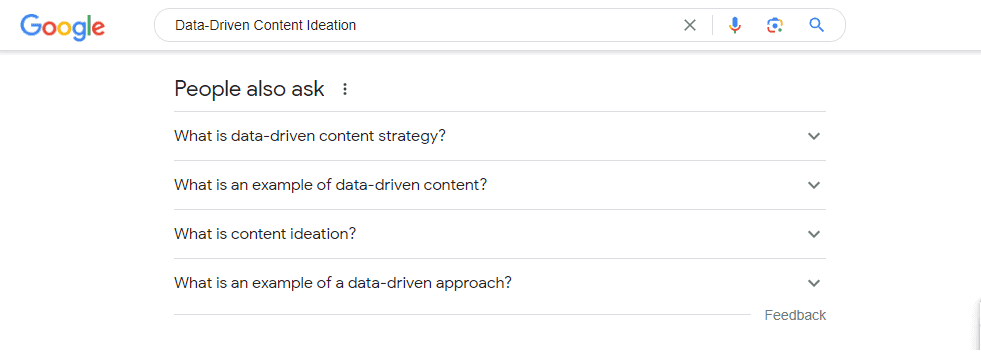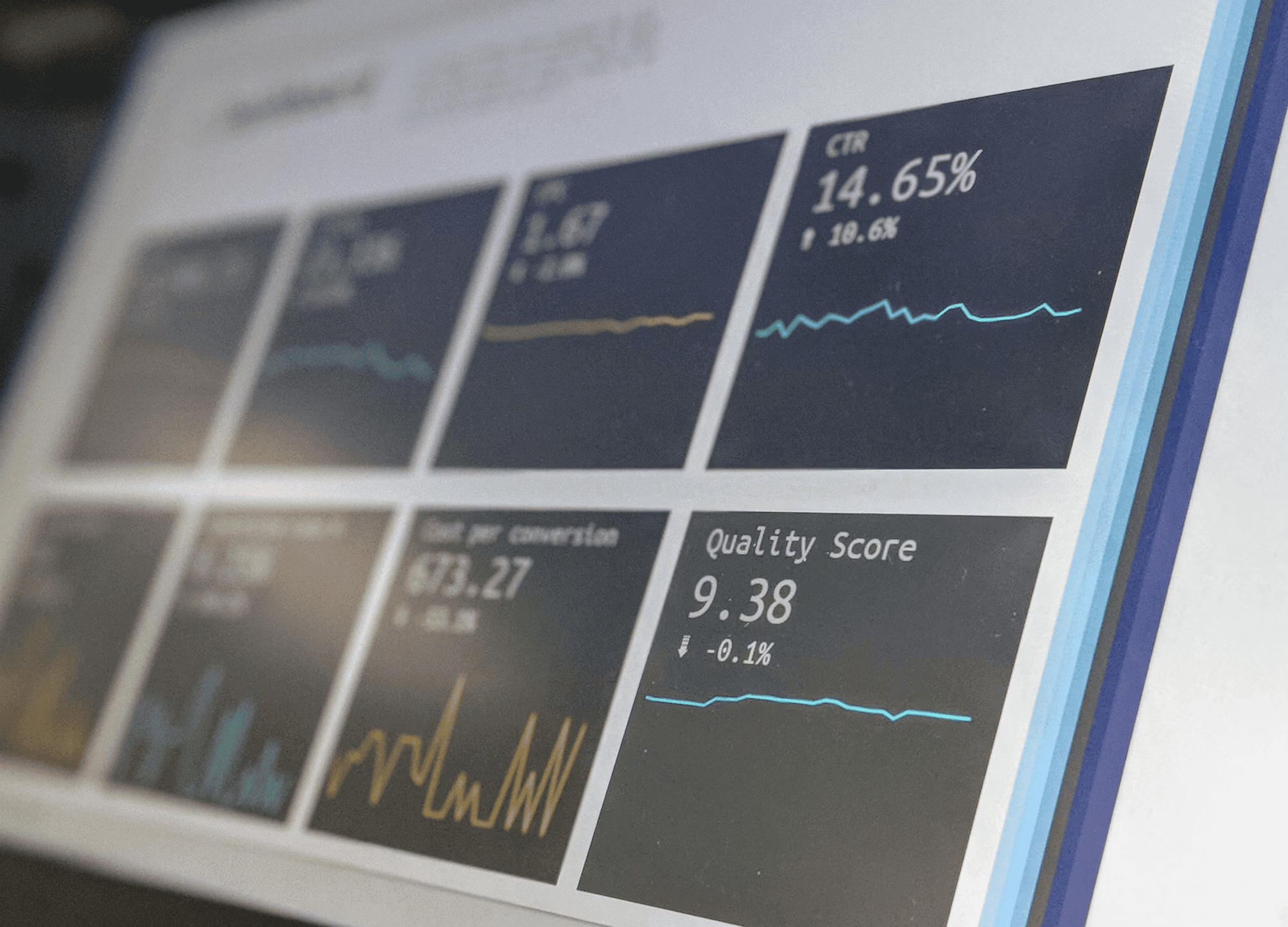There’s an old saying: “Writing is easy. All you have to do is stare at a blank piece of paper until drops of blood form on your forehead.” If you’re a content creator, you probably know that feeling. Finding ideas for content has always been challenging, but with so much competition out there it’s more demanding than ever.
According to Domo, every minute on the internet includes 4 million Facebook posts being liked, nearly 700k Instagram reels being shared, and 43 years worth of streaming content. That’s a lot to compete against, so it’s no wonder creators are turning to data-driven content to generate ideas.

Infographic from Domo’s Data Never Sleeps report
But, before we get into how to generate these ideas, let’s look at the basics:
What is content ideation?
Ideation is the process of generating, developing and communicating ideas. Content ideation involves identifying which content ideas will resonate best with your audience.
What is a data-driven strategy?
A data-driven strategy is any strategy where you collect and analyze information on your current customers, target audience, and the overall market in order to make decisions. With data dictionary tools, organizations can standardize and define data for more accurate analysis and decision-making.
Why Should You Use Data-Driven Content Ideation?
We’ve already highlighted the sheer amount of content that you’ll be competing with, but how can data-driven ideation specifically help you? Here are some of the key benefits:
Easier to create attention-grabbing content
Rather than guessing at what your target audience wants, you can base it on the actual facts. Let’s say you’re a skincare brand, and you’ve written a few different blog posts. Some focus on the science behind your products, some on general wellness topics, and others on fashion trends.
By analyzing metrics like bounce rates, click-through rates, and gathering customer feedback via surveys, you find that the science and wellness topics get a lot of attention, but the fashion trends ones don’t. Now, when planning your future content you can focus on what the audience will pay attention to.
Efficient use of resources
Knowing what your audience wants to see saves you time. Your content team doesn’t need to throw everything at the wall and see what sticks. Instead, their limited time can be spent on things you know will work.
It can help cut costs too – imagine you’re launching a new product, and need photos. By using data-driven insights, you can narrow the shot list down to ones you’re sure will be popular, rather than spending time (and money!) capturing all angles to see what works.
Increased engagement
Not only are you more likely to catch potential customers’ interest in the first place, but by tailoring your content to match their preferences, you can also hold their attention for longer. Plus, if you build a reputation for creating interesting content, people are likely to come back for more.
This increase in engagement means people stay on your site longer, giving you more chances to get your message across to your audience. They might even recommend it to others too!
Better brand awareness
Of course, it’s easy to see how more people coming to your sites would increase your brand awareness.
However, the great thing is that you don’t even need to draw people to your site. Google and other search engines will notice if you’re improving traffic and engagement to your site with your existing audience. That will push you to the top of the results page, meaning even those who never read your content will be made aware of you and your brand.

Screencap of email marketing from Joanie, highlighting their brand values
Improved conversion rates
Ultimately, this is the important one – conversions are the reason you’re creating content for your business in the first place. By making the content your target audience wants and increasing engagement, you’re far more likely to convert potential customers into paying customers, driving sales for your business.
Getting Started with Data-Driven Insights
Now you’ve seen the benefits, you’re probably wondering where to begin. You can’t just jump right in – you need to make sure you’ve gathered the right data, and know what you plan to use it for. Here’s how to get started:
Set goals
The first thing you’ll need to know before you dig into the data is your aim. Do you want to attract more people to your site? Perhaps you want to improve brand awareness, or have a unique product you want to tell the world about? Maybe you just want to solidify your customer base and build subscriptions?
Each of these aims will require a different approach, and knowing what you want to achieve from the get-go will help you stay on track and target your content correctly.
Identify your target audience
Setting your goals should have helped you figure out just who your target audience is, but now it’s time to get into the details. Consider factors like:
- Demographic information such as age, gender, location, income, education, and occupation.
- Psychographic factors – this refers to behaviors and beliefs. Examples include hobbies, such as being into fitness and health or being an avid gamer, and behavioral traits, such as always seeking a bargain.
Imagine you sell high-end, luxury products. Location, income, and occupation are all relevant for targeting the right people. But there is a distinct difference between a socialite with a limitless credit card and a thrifty millionaire, and this is where psychographic factors can really help you hone in.

Free to use image from Unsplash
Gather data on your current audience
Now you know who you want to target, it’s time to find out what they like. One great port of call is your social media, which can provide data on who visits your pages. Remember to speak to your sales staff as well, and give them some outbound calling tips so they collect customer demographics for you when speaking to them directly.
Make sure to monitor interactions with your website too – are there certain pages that get a lot of views, and low bounce rates? You don’t just need information about who your audience are – you also need to understand what they do. What platforms do they interact with you on, what posts do they share, and what leads to conversions? All of this can help when it comes to creating new content.
One way to gather useful data is to request feedback – whether through on-site pop-ups, email surveys, or product reviews. AI tools like sentiment analysis allow you to assess large volumes of text for underlying trends, meaning you can quickly spot common pain points that may need addressing (or positives to highlight).
Ensure data is accessible and usable
Once you’ve got all this data, don’t be tempted to lock it away somewhere. Instead, invest in a storage solution like a data lakehouse which can host all the information you’ve gathered and make it available for analysis.
If you have a good tech team in-house, you can even use AI to do some of this analysis for you. Consider machine learning algorithms like Gradient Boosting Tree vs Random Forest, natural language processing for sentiment analysis, and data visualization to make it easy for your less tech-savvy users to understand.
Turning data-backed insights into content ideas
So you know who your audience are, what they’re interested in, and what has already captured their interest. That alone should give you a solid foundation for content ideas, but you can go even further. Here are some tips to really up your content creation game.
Research your keywords
One way to make sure you’re hitting the mark is by targeting specific keywords. These keywords (which are more commonly phrases rather than single terms, confusingly) are what your audience is typing into their search engine of choice – and where you need to meet them.

Screenshot captured from Google
Start by pretending to be one of your customers and search for a product or service you offer. What results do you get? Check out the ‘People also ask’ section to find out what sort of thing people are searching for. If you can provide them with the answer they’re looking for, you’re well on your way to attracting people to read your content.
You can also use SEO tools to look for keywords that are common, but might not have many results. Imagine you provide data solutions. It’s likely there’ll be a lot of tech-specific terminology around your product, so by creating answer pages like ‘what is medallion architecture’ or ‘how to set up a data pipeline’ you can capture interest – and climb the search engine rankings.
We used two of the questions suggested in the image as the subheadings in this article. By using these search results as headings, this article aims to use data from Google to create content that attracts people interested in content ideation. Does it work? You tell me. You’re the one reading this!
Monitor social media trends
Make sure to pay attention to what’s trending at the moment. That’s not to say you should jump on every trend, but careful timing and clever posts can be a great way to optimize your social media content.
To really succeed here, you should use analytics to cross reference this information with your target audience. If you can find that sweet spot between your offerings, their interests, and what’s trending? Then, voila! You have an idea for perfect data-driven content, guaranteed to resonate with your audience.
Conduct a competitive content gap analysis
We’ve focused a lot on your target audience, but there’s another factor to consider: your competition. By performing a content gap analysis you can find those topics that sit in the Goldilocks zone – fascinating to your customers, ignored by your competitors. Wondering where to start? Here’s a quick overview:
Identify your competitors
Begin by listing businesses offering similar products or services within your niche. That could mean companies competing with you in a specific industry or local competitors if you trade in a more common industry.
Then, focus on 3-5 key competitors who share your target market and have a notable online presence. The chances are, you already know who to focus on, but be sure to do your research too – you may be surprised to find who’s out there vying for the same customers you are.
Collect data
The next step is to visit their websites, blogs and social media profiles. Note what they post, including blog posts, user-generated content and infographics. Try to be systematic in your approach here, categorizing each post.
While collecting this data, note how often they post, and gauge the level of audience engagement through likes, shares and comments.

Free to use image from Unsplash
Analyze content strategies
Now, you need to identify recurring themes and subjects that crop up in your competitor’s content, using the data you have amassed to assess each post’s quality, depth and uniqueness.
You can also use SEO tools to understand how their content is performing. Most SEO platforms offer tools to analyze your competitor’s sites in-depth, allowing you to build a complete picture of their content and how well the public receives it.
Identify the gaps
Look for underrepresented topics or those not at all covered by your competitors. Similarly, try to identify content formats your competitors are neglecting. Finally, pinpoint any missing perspectives or unanswered questions in their content that could represent an opportunity for your brand.
This stage may sound easy, but you’ll find it can require a lot of creativity – after all, you can’t see what’s not there. Instead, you’ll have to use your imagination to fill in the gaps. Using data to ideate content isn’t about bypassing the creative part of content creation; it’s about ensuring you direct your creativity in the right direction.
Measuring Your Success
The final step in using data to drive your content creation is to measure and analyze the results! It’s time to gather even more data – track metrics such as engagement rates, website traffic and, of course, sales. These can tell you how successful your efforts have been and can help you hone your future content publishing strategy.
The Power’s In Your Hands
We live in a world bursting with content, and everybody’s adding to it every day. If you want your content to stand out, you must create something your audience wants to consume.
We also live in the era of big data. Every click we make is measured, and every demographic is filed. If you want to know what your target audience wants, the power is in your hands to find out. Utilizing data for content ideation can increase traffic, improve engagement, and drive sales – so it’s time to dig in.


